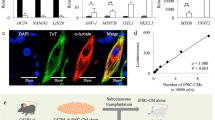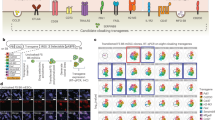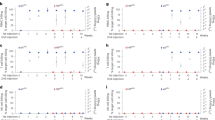Abstract
The transplantation of genetically engineered cells faces limitations associated with host immunity. Allogeneic cells are typically rejected in response to inherent histo-incompatibility. Even autologous cells can induce an immune response toward antigenic molecules expressed following transfer of foreign genes. The goal of the present study was to investigate the ability of immunomodulating molecules co-expressed with biotherapeutic factors to overcome these limitations both in syngeneic and allogeneic cell transplantation. The C2C12 mouse myoblast cell line was engineered to express CTLA4Ig, a soluble factor blocking T cell costimulation, in conjunction with erythropoietin (Epo), a reporter biotherapeutic protein. In syngeneic C3H mice, myoblasts expressing only mouse Epo were mostly rejected within 2 weeks, as indicated by the transient increase in host hematocrit. In allogeneic recipients, the same cells induced only a 1-week increase in the hematocrit reflecting an acute rejection process. CTLA4Ig expression significantly extended the survival of mouse Epo-secreting myoblasts in approximately half of syngeneic hosts, whereas it led only to a 1-week improvement effect in allogeneic recipients. When combined with a transient anti-CD154 treatment, CTLA4Ig expression prevented Epo-secreting C2C12myoblasts from being rejected in allogeneic DBA/2J recipients for at least 1 month. In contrast, the same anti-CD154 treatment alone induced only a 1 week improvement. These results demonstrate that CTLA4Ig co-expression associated with a transient anti-CD154 treatment can prolong the delivery of recombinant proteins via transfer of ex vivo modified cells in allogeneic recipients.
This is a preview of subscription content, access via your institution
Access options
Subscribe to this journal
Receive 12 print issues and online access
$259.00 per year
only $21.58 per issue
Buy this article
- Purchase on Springer Link
- Instant access to full article PDF
Prices may be subject to local taxes which are calculated during checkout








Similar content being viewed by others
References
Grewal IS, Flavell RA . CD40 and CD154 in cell-mediated immunity Annu Rev Immunol 1998 16: 111–135
Lenschow DJ, Walunas TL, Bluestone JA . CD28/B7 system of T cell costimulation Annu Rev Immunol 1996 14: 233–258
Caux C et al. Activation of human dendritic cells through CD40 cross-linking J Exp Med 1994 180: 1263–1272
Larsen CP et al. Long-term acceptance of skin and cardiac allografts after blocking CD40 and CD28 pathways Nature 1996 381: 434–438
Kirk AD et al. CTLA4-Ig and anti-CD40 ligand prevent renal allograft rejection in primates Proc Natl Acad Sci USA 1997 94: 8789–8794
Elwood ET et al. Prolonged acceptance of concordant and discordant xenografts with combined CD40 and CD28 pathway blockade Transplantation 1998 65: 1422–1428
Levisetti MG et al. Immunosuppressive effects of human CTLA4Ig in a non-human primate model of allogeneic pancreatic islet transplantation J Immunol 1997 159: 5187–5191
Parker DC et al. Survival of mouse pancreatic islet allografts in recipients treated with allogeneic small lymphocytes and antibody to CD40 ligand Proc Natl Acad Sci USA 1995 92: 9560–9564
Kenyon NS et al. Long-term survival and function of intrahepatic islet allografts in rhesus monkeys treated with humanized anti-CD154 Proc Natl Acad Sci USA 1999 96: 8132–8137
Kenyon NS et al. Long-term survival and function of intrahepatic islet allografts in baboons treated with humanized anti-CD154 Diabetes 1999 48: 1473–1481
Guerette B et al. Immunosuppression with monoclonal antibodies and CTLA4-Ig after myoblast transplantation in mice Transplantation 1996 62: 962–967
Guerette B, Wood K, Roy R, Tremblay JP . Efficient myoblast transplantation in mice immunosuppressed with monoclonal antibodies and CTLA4 Ig Transplant Proc 1997 29: 1932–1934
Bumgardner GL, Li J, Heininger M, Orosz CG . Costimulation pathways in host immune responses to allogeneic hepatocytes Transplantation 1998 66: 1841–1845
Steurer W et al. Ex vivo coating of islet cell allografts with murine CTLA4/Fc promotes graft tolerance J Immunol 1995 155: 1165–1174
Gainer AL et al. Expression of CTLA4-Ig by biolistically transfected mouse islets promotes islet allograft survival Transplantation 1997 63: 1017–1021
Chahine AA et al. Immunomodulation of pancreatic islet allografts in mice with CTLA4Ig secreting muscle cells Transplantation 1995 59: 1313–1318
Lu L et al. Adenoviral delivery of CTLA4Ig into myeloid dendritic cells promotes their in vitro tolerogenicity and survival in allogeneic recipients Gene Therapy 1999 6: 554–563
Feng S et al. Prolonged xenograft survival of islets infected with small doses of adenovirus expressing CTLA4Ig Transplantation 1999 67: 1607–1613
Yao SN, Kurachi K . Expression of human factor IX in mice after injection of genetically modified myoblasts Proc Natl Acad Sci USA 1992 89: 3357–3361
Barr E, Leiden JM . Systemic delivery of recombinant proteins by genetically modified myoblasts Science 1991 254: 1507–1509
Déglon N et al. Central nervous system delivery of recombinant ciliary neurotrophic factor by polymer encapsulated differentiated C2C12 myoblasts Hum Gene Ther 1996 7: 2135–2146
Régulier E et al. Continuous delivery of human and mouse erythropoietin in mice by genetically engineered polymer encapsulated myoblasts Gene Therapy 1998 5: 1014–1022
Peduto G et al. Long-term host unresponsiveness to encapsulated xenogeneic myoblasts following transient immunosuppression Transplantation 2000 70: 78–85
Bohl D, Heard JM . Modulation of erythropoietin delivery from engineered muscles in mice Hum Gene Ther 1997 8: 195–204
Bonini C et al. HSV-TK gene transfer into donor lymphocytes for control of allogeneic graft-versus-leukemia Science 1997 276: 1719–1724
Riddell SR et al. T-cell mediated rejection of gene-modified HIV-specific cytotoxic T lymphocytes in HIV-infected patients Nature Med 1996 2: 216–223
Jung D et al. Strong immunogenic potential of a B7 retroviral expression vector: generation of HLA-B7-restricted CTL response against selectable marker genes Hum Gen Ther 1998 9: 53–62
Liberatore C et al. Natural killer cell-mediated lysis of autologous cells modified by gene therapy J Exp Med 1999 189: 1855–1862
Garlepp MJ et al. Antigen processing and presentation by a murine myoblast cell line Clin Exp Immunol 1995 102: 614–619
Goebels N, Michaelis D, Wekerle H, Hohlfeld R . Human myoblasts as antigen-presenting cells J Immunol 1992 149: 661–667
Curnow SJ, Willcox N, Vincent A . Induction of primary immune responses by allogeneic human myoblasts: dissection of the cell types required for proliferation, IFNgamma secretion and cytotoxicity J Neuroimmunol 1998 86: 53–62
Yaffe D, Saxel O . Serial passaging and differentiation of myogenic cells isolated from dystrophic mouse muscle Nature 1977 270: 725–727
Gainer AL et al. Improved survival of biolistically transfected mouse islet allografts expressing CTLA4-Ig or soluble Fas ligand Transplantation 1998 66: 194–199
Lew AM et al. Secretion of CTLA4Ig by an SV40 T antigen-transformed islet cell line inhibits graft rejection against the neoantigen Transplantation 1996 62: 83–89
Lin H et al. Cytotoxic T lymphocyte antigen 4 (CTLA4) blockade accelerates the acute rejection of cardiac allografts in CD28-deficient mice: CTLA4 can function independently of CD28 J Exp Med 1998 188: 199–204
Judge TA et al. The role of CD80, CD86, and CTLA4 in alloimmune responses and the induction of long-term allograft survival J Immunol 1999 162: 1947–1951
Zheng XX et al. CTLA4 signals are required to optimally induce allograft tolerance with combined donor-specific transfusion and anti-CD154 monoclonal antibody treatment J Immunol 1999 162: 4983–4990
Guillot C et al. Tolerance to cardiac allografts via local and systemic mechanisms after adenovirus-mediated CTLA4Ig expression J Immunol 2000 164: 5258–5268
Lumsden JM et al. Differential requirement for CD80 and CD80/CD86-dependent costimulation in the lung immune response to an influenza virus infection J Immunol 2000 164: 79–85
Bachmann MF, Zinkernagel RM, Oxenius A . Immune responses in the absence of costimulation: viruses know the trick J Immunol 1998 161: 5791–5794
Zimmermann C, Seiler P, Lane P, Zinkernagel RM . Antiviral immune responses in CTLA4 transgenic mice J Virol 1997 71: 1802–1807
Lane P et al. Expression and functional properties of mouse B7/BB1 using a fusion protein between mouse CTLA4 and human gamma 1 Immunology 1993 80: 56–61
Noelle RJ et al. A 39-kDa protein on activated helper T cells binds CD40 and transduces the signal for cognate activation of B cells Proc Natl Acad Sci USA 1992 89: 6550–6554
Koepke JA . Microhematocrit method. In: Koepke JA (ed) Practical Laboratory Hematology Churchill Livingstone: New York 1991 112–114
Acknowledgements
The authors thank Anne Menoud, Laurence Winkel and Nicolas Bouche for expert technical assistance, Dr William Blanco-Bose for his critical comments on the manuscript and Biogen Inc (Cambridge, MA, USA) for providing the anti-CD154 antibodies. This work was supported in part by Modex Thérapeutics Inc and the Swiss National Science Foundation program ‘Implant and Transplant’.
Author information
Authors and Affiliations
Rights and permissions
About this article
Cite this article
Schneider, B., Peduto, G. & Aebischer, P. A self-immunomodulating myoblast cell line for erythropoietin delivery. Gene Ther 8, 58–66 (2001). https://doi.org/10.1038/sj.gt.3301356
Received:
Accepted:
Published:
Issue Date:
DOI: https://doi.org/10.1038/sj.gt.3301356
Keywords
This article is cited by
-
Cell encapsulation technology as a novel strategy for human anti-tumor immunotherapy
Cancer Gene Therapy (2011)



